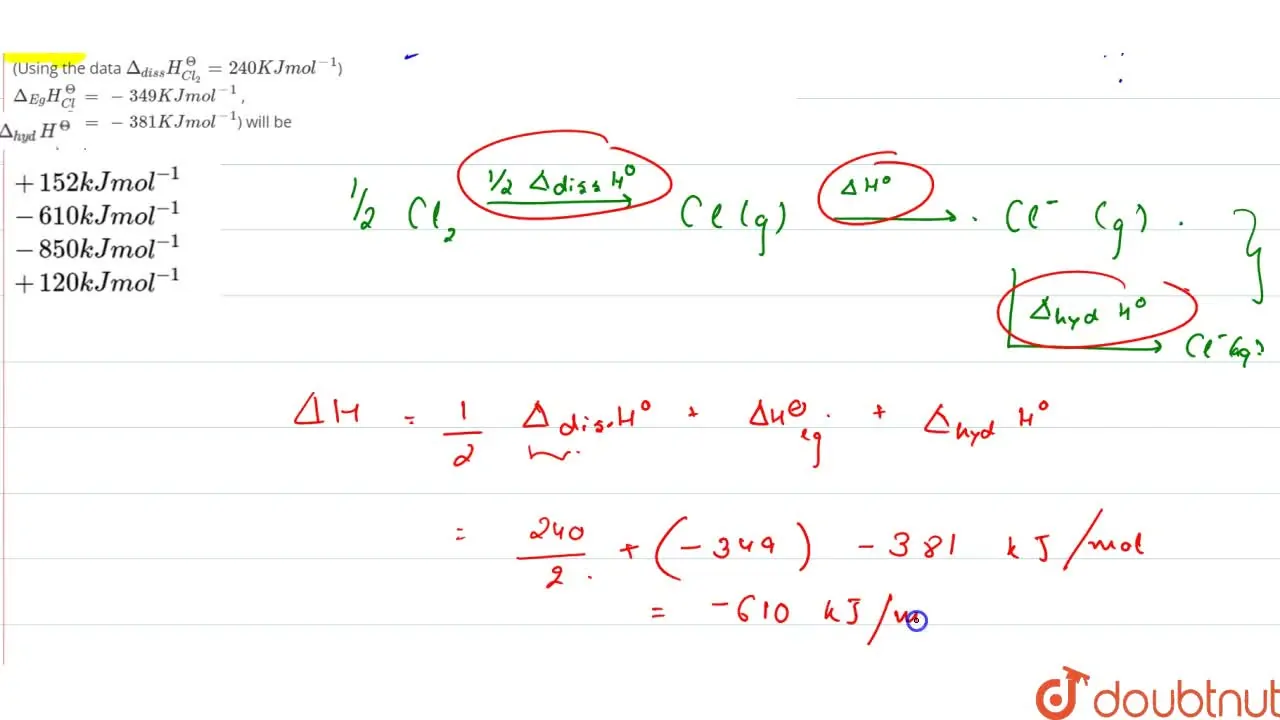Oxidising power of chlorine in aqueous solution can be determined by the parameters indicated below
The energy involved in the conversion of to
(Using the data )
,
) will be
The correct Answer is:B
Step by step video, text & image solution for Oxidising power of chlorine in aqueous solution can be determined by the parameters indicated below (1)/(2)CL_(2)(g)overset((1)/(2)Delta_(diss)H^(Theta))(rarr)Cl(g)overset(DeltaH_(Eg)^(Theta))(rarr) Cl^(-)(g)overset(Delta_(hyd)H^(Theta))(rarr)Cl^(-)(aq) The energy involved in the conversion of (1)/(2)Cl_(2)(g) to Cl^(-)(aq) (Using the data Delta_(diss)H_(Cl_(2))^(Theta)=240KJ mol^(-1)) Delta_(Eg)H_(Cl)^(Theta)=-349KJmol^(-1) , Delta_(Eg)H_(Cl)^(Theta)=-381KJmol^(-1)) will be by Chemistry experts to help you in doubts & scoring excellent marks in Class 12 exams.
Related Playlists
Similar Questions
Oxidising power of chlorine in aqueous solution can be determined by the parameters indicated below
12CL2(g)12ΔdissHΘ−−−−−−→Cl(g)ΔHΘEg−−−→
Cl−(g)ΔhydHΘ−−−−−→Cl−(aq)
The energy involved in the conversion of 12Cl2(g) to
Cl−(aq)
(Using the data ΔdissHΘCl2=240KJmol−1)
ΔEgHΘCl=−349KJmol−1 ,
ΔEgHΘCl=−381KJmol−1) will beView SolutionOxidising power of chlorine in aqueous solution can be determined by the parameters indicated below :
12Cl2(g)12ΔdissHΘ−−−−−−→Cl(g)ΔegH⊕−−−−→Cl−(g)ΔhydHΘ−−−−−→Cl−(aq)
The energy involved in the conversion of 12Cl2 (g) to Cl− (aq) (using the data , ΔdissHΘCl2=240kJmol−1,Δeg=−349kJmol−1,ΔhydHΘCl−=−381kJmol−1) will be -View SolutionOxidising power of chlorine in aqueous solution can be determined by the parameters indicated below :
12Cl2(g)12ΔdissHΘ−−−−−−→Cl(g)ΔegHΘ−−−−→Cl−(g)ΔhydHΘ−−−−−→Cl−(aq)
The energy involved in the conversion of 12Cl2(g) to Cl−(aq)
(using the data, ΔdissHΘCl2=240 kJ mol−1,ΔegHΘCl=−349 kJ mol−1,ΔhydHΘCl−=−381 kJ mol−1) will be -View SolutionOxidising power of chlorine in aqueous solution can be determined by the parameters indicated below
12CL2(g)12ΔdissHΘ−−−−−−→Cl(g)ΔHΘEg−−−→
Cl−(g)ΔhydHΘ−−−−−→Cl−(aq)
The energy involved in the conversion of 12Cl2(g) to
Cl−(aq)
(Using the data ΔdissHΘCl2=240KJmol−1)
ΔEgHΘCl=−349KJmol−1 ,
ΔEgHΘCl=−381KJmol−1) will beView SolutionOxidising power of chlorine in aqueous solution can be determined by parameters indicated below:
12CI2(g)12ΔdissH−−−−−→CI(g)ΔhydH−−−→CI−aq The energy involved in the conversion of 12CI2(g) to CI−(aq) using data, ΔdissHCI2=240kJmol−1, ΔegHCI=−349kJmol−1,ΔhydHci=−381kJmol−1 will beView Solutionoxidising power of chlorine in aqueous solution can be determined by the parameters indicated below: Calculate the energy involved in the conversion of
12Cl2(g)toCl−(aq)
Using the data ,
ΔH∘disso(Cl2)=240KJmol−1,
ΔH∘eg(Cl2)=−349KJmol−1,
ΔH∘hydroation(Cl2)=−381KJmol−1,View SolutionC3H7ClKOH(alc.)−−−−−−−→(A)Cl2(g)−−−−−−→770K(X).(X) can be:
View SolutionAnhydrous AlCl3 is covalent, From the data given below, predict whether if would remain covelent or become ionic in aqueous sobittion [Inization energy for Al =−5137kJmol−1,ΔHHydration for Al3+=−4665kJmol−1, for Cl=−381kJmol−1]
View SolutionFind ΔH of the process
NaOH(s)→NaOH(g)
Given: ΔdissHΘofO2=151kJmol−1
ΔdissHΘofH2=435kJmol−1
ΔdissHΘofO−H=465kJmol−1
ΔdissHΘofNa−O=255kJmol−1
ΔsolnHΘofNaOH=−46kJmol−1
ΔfHΘofNaOH(s)=−427kJmol−1
ΔsubHΘofNa(s)=109kJmol−1View Solutionजलीय विलयन में क्लोरीन की ऑक्सीकरण क्षमता नीचे दिए गए प्राचाल द्वारा निर्धारित की जा सकती है।
12CI2(g)12ΔHdissCI2−−−−−−−→CI(g)12ΔHegCI−−−−−−→CI−(g)12ΔHhydCI−−−−−−→(aq)
1/2 CI_2 (g) " से " CI^(-) (aq) में परिवर्तन में सम्बद्ध ऊर्जा है: (आंकड़ों का उपयोग करके)
ΔHdissCI2=240kJmol−1
ΔHedCI=−349kJmol−1
ΔHhydCI=−381kJmol−1View Solution


